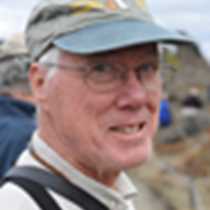Vestmanna to Torshavn, the Faroe Islands
We spent a quiet night in the protected harbor of Vestmanna, on the largest Faroe Island of Stremoy (" ...oy" means "island" in the Faroese language.) The eighteen islands that make up the Faroes are separated by narrow sounds with strong tidal currents. In the olden days inter-island communication was a risky undertaking, and the people were so isolated that separate dialects of the Faroese language developed on the different islands. Now, with financial assistance from Denmark, a system of ferries, bridges and tunnels connects the major islands.
One option for the morning was a long walk over the hills that surround Vestmanna. The incessant wind and over a millennium of grazing by Faroe sheep have shaped the landscape. If there were ever any trees or bushes in the countryside, not a one remains. Rock cairns dating back to the Norse days mark the path over the pastures and fell. Moss and lichens underfoot make walking across the bouncy, verdant, green hills more comfortable than the rocky road. Option B for the morning (or was it group 2 ... or was it yellow ...?) was a trip on local boats to gaze up at the magnificent vertical cliffs and sea stacks of Vestmanna and the myriad seabirds that breed there. It was a paradise for photographers, birders, or just gazers.
In the afternoon we traveled overland by coach to the capital of Torshavn while our ship moved there by sea. We paused to view the remains of Norse stone and turf longhouses, left from the earliest occupation of the Faroes. We then continued to the former ecclesiastical center of Kirkjubøur (pronounced, roughly, cheer-che-bor; the root word Kirkj means church.) It was the residence of the Bishop of the Faroes and hence the islands' most important religious and cultural center before the Protestant Reformation came to the Faroes. Saint Olaf's church, completed in 1111, has been restored and is still in use. Nearby is the shell of St. Magnus' Cathedral. It was begun in the 13th century, in the gothic style, but construction was abandoned when the Reformation came. Now its restoration is underway.
We also visited a farmhouse built on the foundation of the former bishops' palace. On this treeless island the main construction material was driftwood and the remains of wrecked ships; nothing given up by the sea was wasted. The farmhouse has been occupied by seventeen generations of the same family. It is still in use, but several rooms were open to our visit, providing a window into traditional life on the Faroe Islands.


